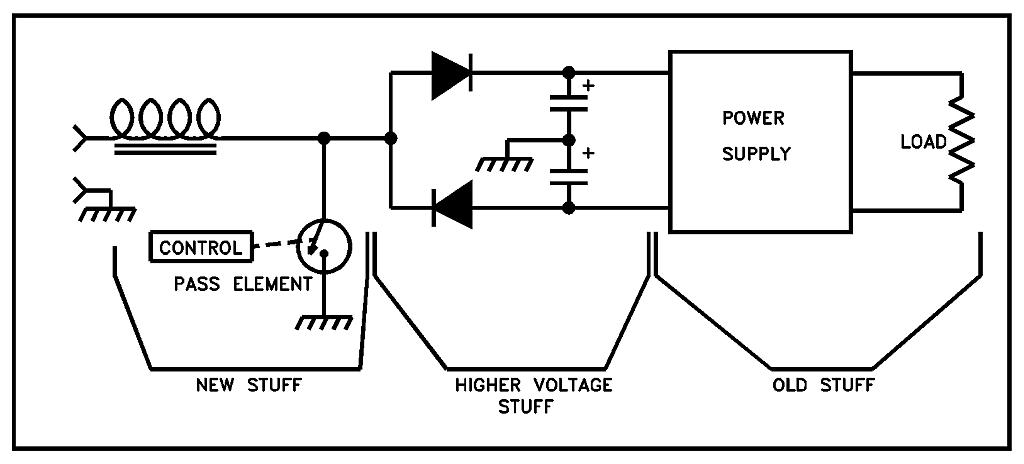| Print, video, sounds |
|
|
With that understood, Let's look at what the hell this power-factor correction is all about. Looky here at this circuit:  . During the first cycle of input voltage the current rushes all lickety split begoshen to fill up the top and then the bottom capacitor. After that the whole mess just sits there. Remember there isn't any load hooked up. The capacitors are charged to the tippy top voltages of the input ac voltage. In this great country of ours it's about 170 volts on the top and -170 volts on the bottom. OK, let's say you hook up a load. It pulls a couple of volts worth of current out of the caps. Now here comes that next plus and minus cycle of input voltage. Well, sakes alive, if the caps are only down a couple of volts nothing happens until the input voltage reaches 168 or -168 volts. Then a passel of current flows into the cap during the small time the voltage is greater than 168 volts. (It's a passel of current as opposed to the whole mess o' current that flowed during the first "inrush" cycle. Professional engineers should be quantitative you know.) Now, look at what you got:  . Little bumps of current that flow only when the input voltage is right at the top or bottom. Them young 'uns will try to impress the boss by calling these current bumps "haversigns" or "higher order harmonics". Us old timers know |
 |
  |
|
what they really are: Little bumps of current. Them little bumps are
what trips the circuit breaker when the peak current is 15 amperes but
the average current ain't even melting the insulation. Them little bumps
are what makes your electric meter spin faster then it should. Them
little bumps radiating away are why my 200 dollar portable phone doesn't
work when I'm on the shop floor. Power factor correction takes out the little bumps. The common, but not exclusive method, is as shown below:  . The pass element could be a tube, relay, transistor FET, IGBT or Maxwell's Demon. The new stuff bumps the voltage to +/- 300 volts. This way the new stuff can be drawing current almost all the time. When you get it goin' the control circuit will buzz the pass element input just right so that the input current is a sign wave just like the input voltage. No little bumps of current. The kids used to call it good karma. Now I guess it would be politically incorrect. Whatever the saying, she'll hang in there pretty good. A word about component selection:Important.Really important. As any Russian schoolchild knows, the inductor specification is critical. If you're pulling 15 amperes you should figure on a half-pounder. Next year you can trim it down. Change a few arbitrarily-chosen passive components at the same time. Throw some |
 |
  |
|
jargon at the boss like "state of the art current-feedback topology,"
or "multi-pole finite-zero all-pass compensation network". This should
nail down that merit raise. You'll already be riding high from the
raise from this year's shipment of product. The pass element package is
based on your bosses shirt:
Crusty McJowl, Empirical Heuristics, 3-18-92 |
 |
  |
This post is in these categories:This post has these tags:
|  |
  |